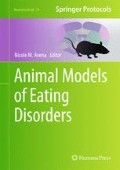Abstract
The eating disorder (ED) anorexia nervosa (AN) is a severe psychiatric disorder. Although the clinical diagnosis of AN has been recognized and included in the American Psychological Association’s Diagnostic and Statistical Manual since the 1980s, the cause of AN remains largely unclear. A number of elements are suggested to be involved in the development of AN, including genetic and contextual. The use of animal models in research efforts to determine the causes of AN and expand upon the existing knowledge concerning the effects of this disorder may lead to significant progress in both understanding and treating this harmful illness.
Access this chapter
Tax calculation will be finalised at checkout
Purchases are for personal use only
References
American Psychiatric Association (2000) Diagnostic and statistical manual of mental disorders: DSM-IV-TR, 4th edn. American Psychiatric Association, Washington, DC
Kaye W, Strober M, Jimerson D (2004) The neurobiology of eating disorders. In: Smith DS, Nestler EJ (eds) The neurobiology of mental illness. Oxford Press, New York, pp 1112–1128
Naughton M, Mulrooney JB, Leonard BE (2000) A review of the role of serotonin receptors in psychiatric disorders. Hum Psychopharmacol 15:397–415
Schultz W (2002) Getting formal with dopamine and reward. Neuron 36:241–263
Bailer UF, Kaye WH (2003) A review of neuropeptide and neuroendocrine dysregulation in anorexia and bulimia nervosa. Curr Drug Targets CNS Neurol Disord 2:53–59
Rolls ET (2010) Taste, olfactory and food texture reward processing in the brain and obesity. Int J Obes (Lond) 35:550–561
Kelley AE et al (2005) Corticostriatal-hypothalamic circuitry and food motivation: integration of energy, action and reward. Physiol Behav 86:773–795
Carmichael ST, Price JL (1996) Connectional networks within the orbital and medial prefrontal cortex of macaque monkeys. J Comp Neurol 371:179–207
Kelley AE, Berridge KC (2002) The neuroscience of natural rewards: relevance to addictive drugs. J Neurosci 22:3306–3311
Frank GK et al (2005) Increased dopamine D2/D3 receptor binding after recovery from anorexia nervosa measured by positron emission tomography and [11c]raclopride. Biol Psychiatry 58:908–912
Fladung AK et al (2010) A neural signature of anorexia nervosa in the ventral striatal reward system. Am J Psychiatry 167:206–212
Wagner A et al (2008) Altered insula response to taste stimuli in individuals recovered from restricting-type anorexia nervosa. Neuropsychopharmacology 33:513–523
Wagner A et al (2007) Altered reward processing in women recovered from anorexia nervosa. Am J Psychiatry 164:1842–1849
Kaye WH, Fudge JL, Paulus M (2009) New insights into symptoms and neurocircuit function of anorexia nervosa. Nat Rev Neurosci 10:573–584
Halmi KA (2009) Perplexities and provocations of eating disorders. J Child Psychol Psychiatry 50:163–169
Bulik CM (2005) Exploring the gene-environment nexus in eating disorders. J Psychiatry Neurosci 30:335–339
Johnson PM, Kenny PJ (2010) Dopamine D2 receptors in addiction-like reward dysfunction and compulsive eating in obese rats. Nat Neurosci 13:635–641
Avena NM, Rada P, Hoebel BG (2008) Underweight rats have enhanced dopamine release and blunted acetylcholine response in the nucleus accumbens while bingeing on sucrose. Neuroscience 156:865–871
Aoki C et al (2012) Adolescent female rats exhibiting activity-based anorexia express elevated levels of GABA(A) receptor alpha4 and delta subunits at the plasma membrane of hippocampal CA1 spines. Synapse 66(5):391–407
Author information
Authors and Affiliations
Corresponding author
Editor information
Editors and Affiliations
Rights and permissions
Copyright information
© 2013 Springer Science+Business Media, LLC
About this protocol
Cite this protocol
Frank, G.K.W. (2013). Introduction: Anorexia and Undereating. In: Avena, N. (eds) Animal Models of Eating Disorders. Neuromethods, vol 74. Humana Press, Totowa, NJ. https://doi.org/10.1007/978-1-62703-104-2_15
Download citation
DOI: https://doi.org/10.1007/978-1-62703-104-2_15
Published:
Publisher Name: Humana Press, Totowa, NJ
Print ISBN: 978-1-62703-103-5
Online ISBN: 978-1-62703-104-2
eBook Packages: Springer Protocols

